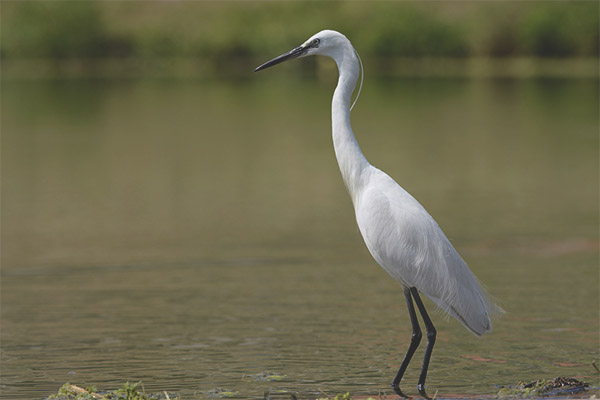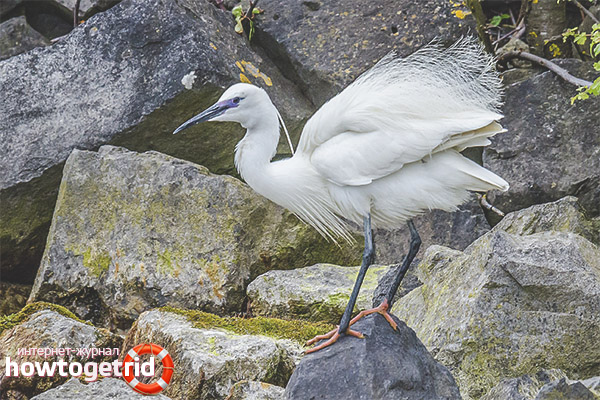The content of the article
The Little Egret is a medium-sized bird of the heron family, mostly living in swamps. It is most often found in the eastern hemisphere, which is explained by the most attractive climatic conditions.
Outwardly, this marsh bird is very similar to its congener - the great white heron, but differs from it in some striking details:
- significantly smaller sizes;
- some details of the color of the legs of the bird and its beak;
- elongated thoracic and occipital feathers.
The main habitat is various water sources, the water of which can be both flowing and stagnant; shallow lakes, floodplain forests, moorland.
This bird is almost not afraid of man, often herons of this species can be found near farms and cattle pastures. It feeds mainly on small fish, snails and frogs.
Description
The plumage is exclusively white. Also in nature there are also herons of completely black color, their main characteristic feature is a pure white chin, but this is a very rare phenomenon. This kind of small herons has a special definition of "morph".
A characteristic feature of the male during the marriage hunt is the presence of long tufts (egret), located in the back of the head, chest and shoulders of the bird. Such tufts consist of undistorted feathers. The beak is perfectly black. The space between the eye and the beak has no plumage, and at certain periods of time has a different color:
- during the mating season - reddish;
- all the rest of the time is a blue-gray tint.
The color of the legs of the bird is black with a characteristic yellow metatarsus (in young specimens, the plus color is greenish). The only difference between males and females is the presence of decorating egret.
As a rule, the white heron is unsociable (the exception is the breeding season). The cries of birds are quite loud and look like extended caws. Sometimes it may make hoarse short interrogative sounds. During the flight strongly pulls the neck.
Natural habitat conditions
For its nesting, small herons prefer to choose coastal forests with dry scrub, thickets, and other vegetation of medium height. This bird is often found outside water bodies, poplar groves, open swamps, small canals and rice fields. In this case, the pasture for livestock and the surrounding area serve as a place for feeding and nesting.
Migration Features
The white heron, which lives mainly in the tropics, is a more sedentary bird, partly nomadic. Palearctic type populations are migratory; their main wintering places are Southeast Asia and Africa.
Breeding white herons
The main time for breeding populations of small herons in such a part of the globe as Europe and Central Asia is the period from March to July.For birds living in the rest of the range, this period is closely related to the beginning of the rainy season. In most cases, the nesting of small herons is mono-shaped. However, cohabitation with other wading birds (cormorants, small spears, different species of heron family) is not excluded.
The sizes of such mixed colonies often reach several thousand pairs. When independent settlement - the number of pairs in the colony of small white herons rarely exceeds a hundred. Lonely breeding pairs are extremely rare.
The nest has the characteristic shape of an inverted cone, the width of the walls of which does not exceed 35 cm. As a rule, it is arranged by birds on the crest of reed or reed thickets, not too high from the surface of the water. To create a nest birds use long dry twigs. Also, often a place for a nest is a low tree or thickets of shrubs, in this case, the grass stems are used as material for it.
I would like to note that quite often the birds, instead of creating a new nest, are occupied by empty old ones left over from other herons. When arranging the “home” one can notice a kind of distribution of responsibilities - the task of the male:the extraction of building material, the female heron is engaged in its direct installation.
In the colonies of herons, which have rather large sizes, the maximum distance between bird nests is about 4-5 meters, the minimum is less than a meter. Note that this is an extremely rare phenomenon. The average number of eggs of one individual is from 2 to 6 pcs. Laying eggs in the tropics is much less.
Eggs of small herons are distinguished by a delicate bluish-green shade with a faint brilliance, their laying is carried out at intervals of up to two days. The duration of hatching is quite long and is about 25 days, while hatching is an occupation of both parents, although it is the female who spends most of her time in the nest.
The nestlings born into the world are covered with a rare white fluff, feeding is carried out by both parents (burping food from the beak to the beak). Grown-up chicks begin to leave the nest already after three weeks, for this, during daylight hours, they move to branches of nearby shrubs / trees that have a small height. The manifestation of the ability to fly in young individuals appears already after 6-7 weeks.As a rule, after this the young birds leave the parental nest forever, while they try to keep close to the flocks that hunt in the nearest feeding areas. The average life expectancy of such a heron is about five years.
Power Features

The basis of the diet of white herons is small fish weighing up to 20 grams. In addition, these birds are happy to eat land and aquatic insects, frogs, mollusks, crustaceans / arachnids, small birds and reptiles. As a rule, this marsh bird feeds mainly in shallow water, using different methods for catching food, for example, for a long time, spending in one place, waiting for its prey. Or prey on suitable animals, quickly catching up with her. Note that during the nesting period the distance between the nest itself and the fodder territory preferred by the bird can reach several kilometers (up to 13 km).
Subspecies
There are several subspecies of the egret, but the most famous of them are just two.
Egretta Garzetta - is a nominative subspecies of wading birds, the most common in Asia, Africa and MI Europe.
The next known subspecies is Egretta Nigripes, mainly inhabiting Australasia and Indonesia.
Also, there is often a mention of such a subspecies of small white herons as - E. g. Immaculata are marsh birds, whose main habitat is Australia.
I would like to note that, until recently, a considerable number of other independent species were attributed to subspecies of the white heron. For example, they include the coastal heron that lives in coastal regions of Asia and in Africa. Another species of wading birds, which was previously attributed to this subspecies of small herons, is the so-called reef species, which can be found in the countries of East Africa, the Comoros and Madagascar.
Video: Little Egret (Egretta garzetta)












To send